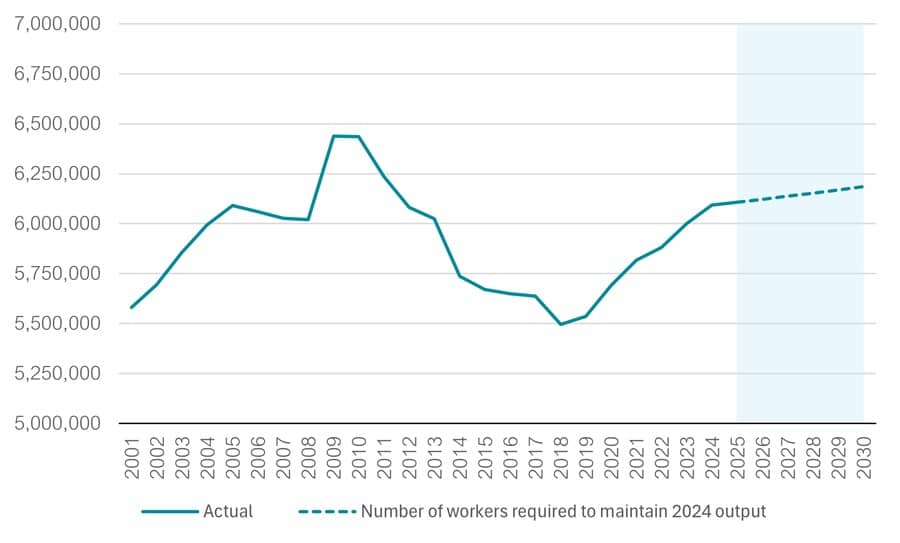The latest UK public sector output data are sounding alarm bells. Public sector productivity has declined for a second consecutive year and remains firmly short of pre-pandemic levels.
Alongside this, employment costs are rising sharply, putting strain on the public purse at a time when fiscal headroom is already tight.
The UK’s overall productivity has experienced persistent sluggishness since the global financial crisis and the country measures poorly relative to several of its peers.
In 2023, the UK ranked below both Germany and France on productivity. Meanwhile, relative to the US, productivity in the UK was 19% lower.
The productivity slump in the public sector specifically has been a more recent phenomenon. This metric took a sharp hit from the pandemic and has since failed to recover.
In addition to remaining short of 2019 levels, the two recent declines in this variable mean that public sector productivity is now even lower than it was in 1997, marking cause for concern.
The fiscal fallout: paying more for less
Declining productivity has direct and unwelcome fiscal consequences. To maintain current output, more workers must be employed to offset the reduced output per labour unit.
If the recent trend of falling productivity continues, the public sector would need to hire an estimated 92,000 additional workers by the end of the current parliament, just to sustain existing public service levels.
However, this challenge is not limited to workforce expansion. Hiring more employees requires additional labour costs, a pressure that is compounded by strong earnings growth. Higher wages also drive-up other employment-related costs, particularly employers’ National Insurance Contributions (NICs) and public sector pension obligations. With productivity falling and employment costs rising, the Government finds itself in the unfavourable position of paying more for less.

We estimate that the labour costs for the additional 92,000 workers would amount to £5.1 billion by 2030. This potential cost poses a challenge within the constraints of the UK’s current budgetary framework and already limited fiscal headroom.
Fiscal constraints and policy challenges
The UK government faces fiscal rules requiring a current budget surplus and a reduction in net public sector debt as a percentage of GDP by 2029/30. These constraints limit the ability to increase public sector spending. Notably, the rise in labour costs needed to maintain current output amidst declining productivity would take up more than half of the Government’s available fiscal headroom, forecasted at £9.9 billion in 2029/30 by the Office for Budget Responsibility. This highlights the Treasury’s lack of room for manoeuvre.
Expanding the workforce to offset productivity declines may create a tension between maintaining public services and meeting fiscal targets. Policymakers could be caught between a rock and a hard place: either accept deteriorating output by not hiring more or risk eating up their fiscal wiggle room with additional staffing costs. Of course, there is a third option of addressing productivity directly, taking measures to boost output per worker through skill development, operational changes, or otherwise.
Further compounding this challenge is the question of labour supply. Public services, notably in health and social care, have historically relied on international recruitment to help fill workforce gaps. Recent immigration reforms, which aim to reduce net migration while prioritising high-skilled entrants, may limit the availability of workers in these essential sectors.
While these policies may support longer-term labour market objectives, they could also limit the public sector’s capacity to respond to falling productivity. Research suggests that migrant workers tend to be more productive than UK-born workers, meaning immigration could play a valuable role in easing workforce pressures and improving overall efficiency.
They are also often cheaper, which would help to restrict cost pressures from domestic wage inflation.
The UK’s productivity puzzle is not new, but the fiscal stakes are now higher than before. Under the dual headwinds of shrinking productivity and rising wages, the public purse is under mounting pressure to maintain its staffing costs and output. Policymakers will need to consider how to boost efficiency while navigating tight fiscal rules and a changing labour market. Failure to act risks a growing black hole in public finances, with taxpayers footing the bill for more staff delivering less output.






Leave a Comment